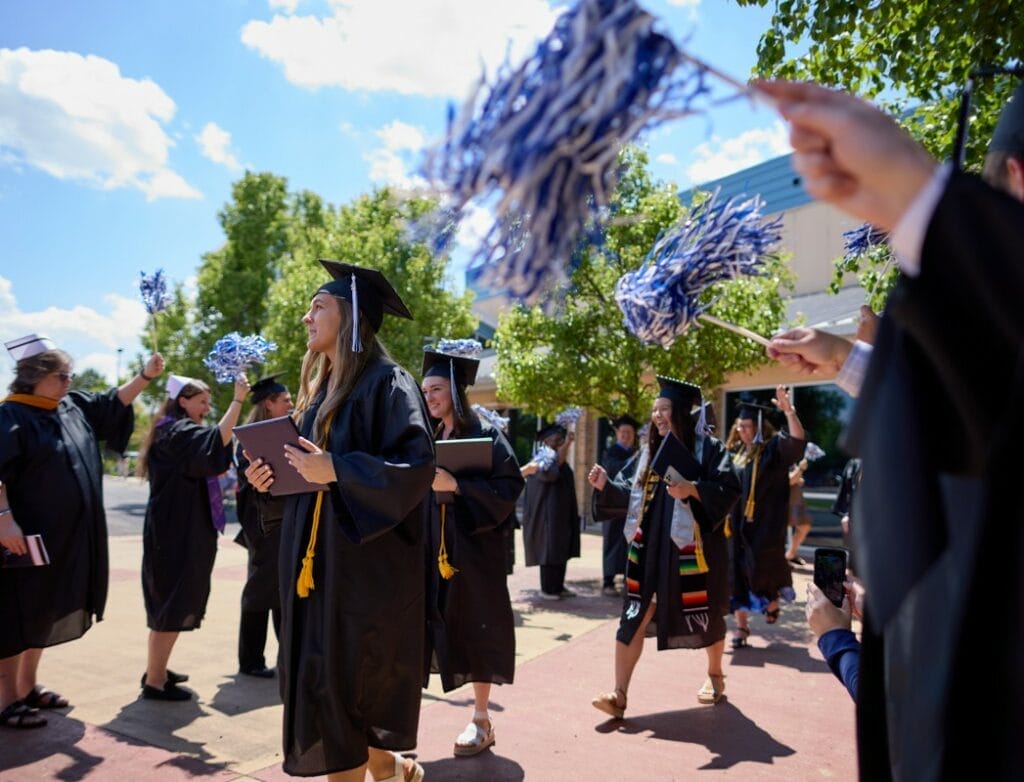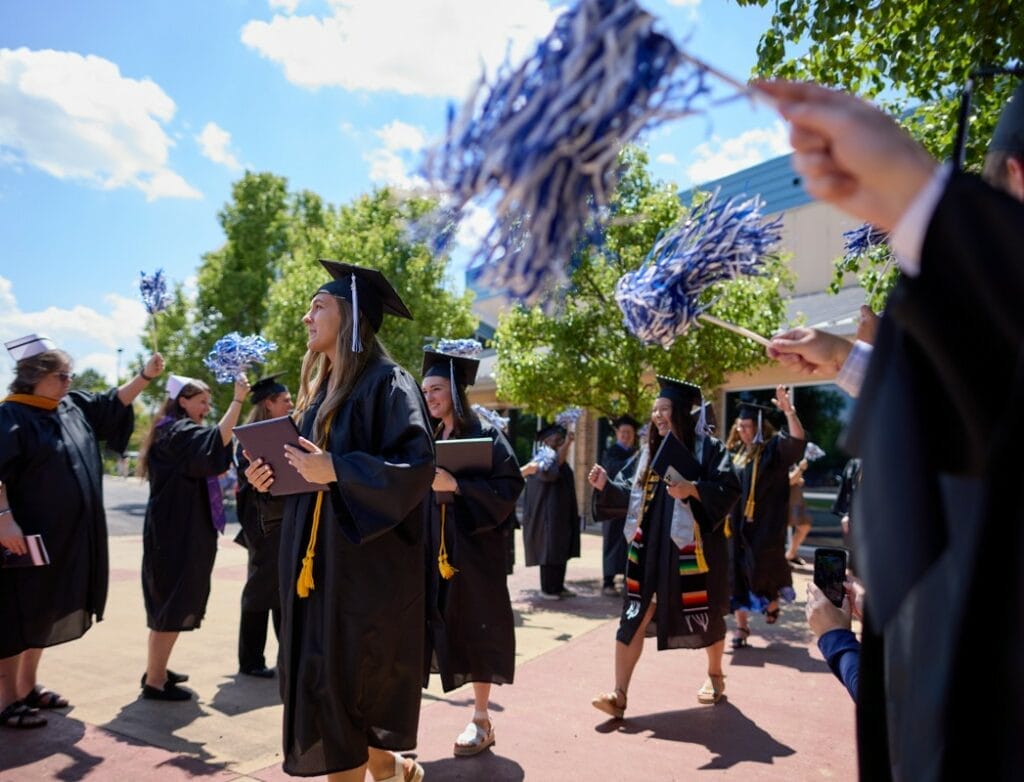This post originally appeared at https://www.badgerinstitute.org/wisconsin-students-can-easily-walk-away-from-two-year-colleges/
Proximity to technical schools a primary reason to explore further closure
Of the seven remaining two-year branch colleges in the Universities of Wisconsin system, three are within walking distance and the rest are within easy driving distance of technical colleges that now are offering many of the same liberal arts courses.
Marshfield is about 38 miles west of the University of Wisconsin-Stevens Point and hosts a two-year college affiliated with it, but its residents are within walking distance of the Marshfield campus of Mid-State Technical College. Wausau is 33 miles north of UW-Stevens Point’s main campus and it also hosts a two-year college affiliated with it, but that college is just 2.4 miles south of Northcentral Technical College’s main campus.

Lakeshore Technical College has campuses in Manitowoc and Sheboygan. Even though UW-Eau Claire Barron is 57 miles north of the main campus, it’s walking distance to Northwood Technical College’s main campus.
And while Rock County is the healthiest of the UW’s remaining two-year branches, it is also just six miles north of Blackhawk Technical College, just south of Janesville.
UW-Platteville at Baraboo Sauk County is 85 miles northeast of its parent campus, farthest of all the two-year schools from its parent, a geographical quirk of the reorganization in 2018 when all two-year colleges became branches of four-year universities.
However remote it seems, the Baraboo Sauk County is flanked 20 miles to the east by the Portage campus of Madison College, as that city’s technical college brands itself, and 15.7 miles to the west by Madison College’s Reedsburg campus.
As the Badger Institute reported last week, a legislative study committee is raising serious questions about the need and the students’ desire for the schools. Enrollment in the UW two-year campuses is down 64% since 2000, and since spring, six of the 13 schools have either closed or have been scheduled to close by spring 2025.
The Badger Institute took a look at what’s left of the two-year colleges and what are some of the alternatives should more of them close.
The seven remaining schools — UW-Green Bay’s Sheboygan and Manitowoc campuses, UW-Whitewater Rock County, UW-Platteville Baraboo Sauk County, UW-Eau Claire Barron, and the UW-Stevens Point campuses in Marshfield and Wausau — had a combined enrollment last year of 2,855, 1.76% of the systemwide enrollment of 162,531 in 2023, according to system data.
The Marshfield and Wausau campuses had a combined enrollment drop of 13.5% in a single school year, and school officials say without a sharp turnaround they will have to close.
Total enrollment for those seven schools was up 2.4%. Four of the schools had enrollment increases, led by Rock County, which grew by 17.4%.
In April, the Sauk County Board approved spending $390,000 in county tax money to cover operating costs for a branch that saw an enrollment increase from 179 to 210 students but is the smallest of the remaining branches.
Last week, school officials announced that Baraboo Sauk County was closing four of its five buildings, making it a one-room schoolhouse. Brandon Lohr, a county board member and member of the City of Baraboo’s Campus Commission, told a local reporter, “It’s a little disheartening to hear this news, but it’s also inevitable. I think it makes sense.”
Shawna Marquardt, Madison College’s dean of regional campuses, told the Badger Institute, “It is hard to say if we have picked up enrollments specific to the impending changes at the UW-Platteville Baraboo Campus, but our enrollment numbers for fall between our Reedsburg and Portage campuses are up 15% in headcount and 27% in FTE (full time equivalent) compared to this time last year.”
While it’s impossible to say whether the academic needs of every one of the students at the remaining two-year campuses could be met, the Wisconsin Technical College System has adapted to the needs of students who do not want to start out at four-year schools.
Still far behind enrollments in the years before COVID, overall technical college enrollment in the state is up 15.9%, from 248,534 in 2021 to 287,951 in 2023, according to system data.
At the same time that the two-year UW campuses at Wausau and Marshfield were shedding students, enrollments were up slightly at the corresponding Northcentral and up by 29.7% at Mid-State, according to the data.
Enrollments were up at three other technical colleges corresponding to two-year UW branches, and it was down in two where the corresponding two-year UW schools, Rock County and Barron, saw enrollment increases, according to the data.
In a finding that surprised some, the Wisconsin Policy Forum in January found that students attending technical colleges in the state were better funded than their four-year counterparts — $17,419 per full-time equivalent for technical college students, compared to $16,036 in 2022.
Programs are developed and set from campus to campus, but passage of the Universal Credit Transfer Agreement between the UW system and the technical college system in the fall of 2021 has provided a base of courses in communications, the humanities and natural science that has made transferring credits from technical colleges to two- and four-year universities much easier.
Increasingly, those courses can be taken at home rather than in a classroom. At the same time that Universities of Wisconsin System President Jay Rothman is asking for more funding for university system infrastructure, he is pressing the system to catch up to the rest of the Midwest in online education.
The UW system in February brought online.wisconsin.edu online, one of the recommendations made in a report by the UW’s Online Strategic Growth Task Force. The website allows students to enroll in classes in 99 bachelor’s, 95 master’s and 10 associate degree programs.
More than 18,000 UW students are fully online. Between 25% and 80% of the students enrolled in the state’s 13 four-year universities are taking at least one class online, according to the report.
Across all of Madison College campuses, more than 43% of the full-time equivalents are fully online, more than twice the percentage before COVID, Marquardt said. More than 40% of the students at Madison College are working parents, she said.
“We will likely continue to see our academic portfolio be invested in online and hybrid options to accommodate our working students, student parents, and those with transportation challenges,” Marquardt said.
Rothman would like to see that participation rate go much higher. In comparison with other public four-year institutions, Wisconsin’s online enrollment percentage in 2021 was lower than all the adjoining states, Indiana, Kansas, Nebraska, Ohio and North and South Dakota, the report said.
Rothman this week said he intends to ask for $855 million more in the state’s 2025-27 budget than was budgeted in this past biennium. The system estimates it expects to spend $8 billion over this coming school year alone.
Rothman reaffirmed his commitment to keeping two year branch campuses open, but there is nothing in his $855 million request that specifically includes a funding boost for what remains of the beleaguered system.
Mark Lisheron is the Managing Editor of the Badger Institute. Permission to reprint is granted as long as the author and Badger Institute are properly cited.
Submit a comment
“*” indicates required fields
/* = 0;if(!is_postback){return;}var form_content = jQuery(this).contents().find(‘#gform_wrapper_21’);var is_confirmation = jQuery(this).contents().find(‘#gform_confirmation_wrapper_21’).length > 0;var is_redirect = contents.indexOf(‘gformRedirect(){‘) >= 0;var is_form = form_content.length > 0 && ! is_redirect && ! is_confirmation;var mt = parseInt(jQuery(‘html’).css(‘margin-top’), 10) + parseInt(jQuery(‘body’).css(‘margin-top’), 10) + 100;if(is_form){jQuery(‘#gform_wrapper_21’).html(form_content.html());if(form_content.hasClass(‘gform_validation_error’)){jQuery(‘#gform_wrapper_21’).addClass(‘gform_validation_error’);} else {jQuery(‘#gform_wrapper_21’).removeClass(‘gform_validation_error’);}setTimeout( function() { /* delay the scroll by 50 milliseconds to fix a bug in chrome */ jQuery(document).scrollTop(jQuery(‘#gform_wrapper_21’).offset().top – mt); }, 50 );if(window[‘gformInitDatepicker’]) {gformInitDatepicker();}if(window[‘gformInitPriceFields’]) {gformInitPriceFields();}var current_page = jQuery(‘#gform_source_page_number_21’).val();gformInitSpinner( 21, ‘https://e74sq7k37a8.exactdn.com/wp-content/plugins/gravityforms/images/spinner.svg’, true );jQuery(document).trigger(‘gform_page_loaded’, [21, current_page]);window[‘gf_submitting_21’] = false;}else if(!is_redirect){var confirmation_content = jQuery(this).contents().find(‘.GF_AJAX_POSTBACK’).html();if(!confirmation_content){confirmation_content = contents;}jQuery(‘#gform_wrapper_21’).replaceWith(confirmation_content);jQuery(document).scrollTop(jQuery(‘#gf_21’).offset().top – mt);jQuery(document).trigger(‘gform_confirmation_loaded’, [21]);window[‘gf_submitting_21’] = false;wp.a11y.speak(jQuery(‘#gform_confirmation_message_21’).text());}else{jQuery(‘#gform_21’).append(contents);if(window[‘gformRedirect’]) {gformRedirect();}}jQuery(document).trigger(“gform_pre_post_render”, [{ formId: “21”, currentPage: “current_page”, abort: function() { this.preventDefault(); } }]); if (event && event.defaultPrevented) { return; } const gformWrapperDiv = document.getElementById( “gform_wrapper_21” ); if ( gformWrapperDiv ) { const visibilitySpan = document.createElement( “span” ); visibilitySpan.id = “gform_visibility_test_21”; gformWrapperDiv.insertAdjacentElement( “afterend”, visibilitySpan ); } const visibilityTestDiv = document.getElementById( “gform_visibility_test_21” ); let postRenderFired = false; function triggerPostRender() { if ( postRenderFired ) { return; } postRenderFired = true; jQuery( document ).trigger( ‘gform_post_render’, [21, current_page] ); gform.utils.trigger( { event: ‘gform/postRender’, native: false, data: { formId: 21, currentPage: current_page } } ); if ( visibilityTestDiv ) { visibilityTestDiv.parentNode.removeChild( visibilityTestDiv ); } } function debounce( func, wait, immediate ) { var timeout; return function() { var context = this, args = arguments; var later = function() { timeout = null; if ( !immediate ) func.apply( context, args ); }; var callNow = immediate && !timeout; clearTimeout( timeout ); timeout = setTimeout( later, wait ); if ( callNow ) func.apply( context, args ); }; } const debouncedTriggerPostRender = debounce( function() { triggerPostRender(); }, 200 ); if ( visibilityTestDiv && visibilityTestDiv.offsetParent === null ) { const observer = new MutationObserver( ( mutations ) => { mutations.forEach( ( mutation ) => { if ( mutation.type === ‘attributes’ && visibilityTestDiv.offsetParent !== null ) { debouncedTriggerPostRender(); observer.disconnect(); } }); }); observer.observe( document.body, { attributes: true, childList: false, subtree: true, attributeFilter: [ ‘style’, ‘class’ ], }); } else { triggerPostRender(); } } );} );
/* ]]> */
The post Wisconsin students can easily walk away from two-year colleges appeared first on Badger Institute.
